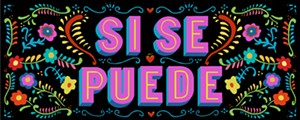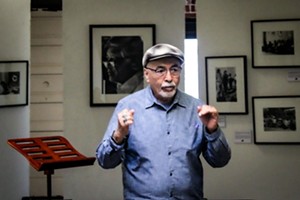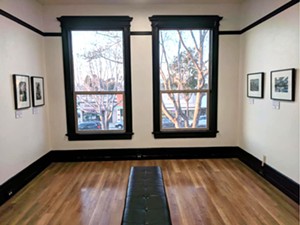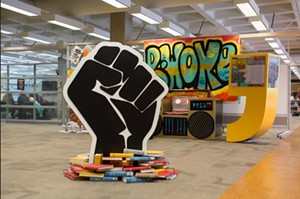At the heart of the city, on Broadway and Main Street heading west, there is a building that reminds one of a bygone era. Entering the site under a distinctive black awning, visitors are greeted by a two-tiered staircase with intricate molding and craftsmanship.

Corazón del Pueblo Cultural and Creative Arts Center of the Santa Maria Valley has found a long-awaited home here. The new center at 124 W. Main St., suite E—in the historic W. A. Haslam & Co. building, established in 1906—will serve as a cultural hub that addresses a multitude of concerns and needs expressed by Santa Maria’s Latino community for more than three decades.
Corazón del Pueblo Executive Director Alma Hernandez said she’s excited for the future of the Latino community and the people of the region as a whole.
“It was a need that was expressed 35 years ago by youth in our city to have a place to celebrate and embrace their heritage. Corazón del Pueblo is not going to be a service-only nonprofit. The cultural center is for people of all ages to bring their gifts and talents to share with everyone besides the artists and professionals we bring in,” she said. “We want the community members to be able to connect and share their stories.”
The cultural center’s vision is to serve as a sanctuary for locals to discover and experience arts and culture. Hernandez’s first step was to seek out Ruben Espinoza, a local artist, community advocate, and business owner of Chingon Design Company, known for his love of murals and working with underserved youth throughout Santa Maria.
Espinoza, who received his Bachelor of Fine Arts degree with an emphasis in animation from CSU Fullerton, now serves on the local center’s board. He also works as the event and exhibit coordinator, working to secure funding as well as bring in artists and their works for display.
Espinoza also designed the artwork for the center’s mural to represent and embrace the heritage and traditions of the Latino community.
“Our culture will be celebrated at Corazón del Pueblo, and we also want everyone to be exposed to art in general and all the talent and expression we have here on the Central Coast,” Espinoza said. “It is more than tradition. We want everything and everyone to be included, and we need to bring people together and not let hate and frustration drive them apart.

“Art does that,” he said.
Poet Laureate Juan Felipe Herrera from the Central Valley spoke and answered questions at the cultural center’s official opening on March 31. Herrera—the nation’s 21st poet laureate, serving from 2015 to 2017—was the first Latino to receive that distinction. He’s known for his autobiographical poems on immigration, the Chicano identity, and his life in California. During the Santa Maira cultural center’s opening, Herrera spoke of heritage, tradition, and pride and of his challenges and experiences while growing up.
Espinoza, beyond helping to bring Herrera and his poems to the city, said that in collaboration with Cal Poly’s Robert E. Kennedy Library, the cultural center will be hosting a hip-hop exhibition in August. The exhibit focuses on the elements and traditions of the hip-hop culture and addresses truth and social injustice, he said.
In 2017, Hernandez began working on the cultural center’s plans after hearing ongoing concerns about the youth in the Latino community, including losing friends to gangs, worrying about their future, and where they belong in it.
Through her professional and leadership studies, she created a step-by-step plan to start a nonprofit that would provide a space for the Latino community to connect with one another and find a cultural identity built around expression through art and defining their own individuality.
Hernandez said that at the beginning of the project, there was an enormous amount of paperwork, deadlines, and details to take care of, and one of her first priorities was enlisting a diverse board—representing different ages, races, and genders.
“The need had been voiced, and no one was listening,” Hernandez said. “[Youth] are a part of our community, an invaluable voice that we want to listen to and let them know, this time they are being heard.
“Their voice will be listened to,” she said, “and the cultural center is not going to disappear or be taken away. It will be their home away from home.”
La concepción: The conception
After a surge in teen and gang violence in 2016, the youth leadership programs of the area joined together for the Just Community Summit to get to the heart of the frustration that was growing among Santa Maria youth. What was needed? What was missing? These were just some of the questions needed to be answered.

Local nonprofits and their youth representatives were invited to speak during the summit and said they felt displaced and like they didn’t have a voice or recognition within their own community. Speakers told the city and local nonprofits that they needed a center, a safe place for them to exchange ideas and open up communication. Hernandez said their message was clear: They wanted to be listened to and heard and to talk openly without judgement. They wanted to ask questions, be told the truth, and share their feelings and thoughts with friends and family.
The results of the 2016 summit helped fuel Hernandez’s passion for addressing the need for the cultural center. Through her work with the Santa Barbara Foundation’s Leading from Within course, she decided it was time to take action. Using stories she heard from her own children and their friends as motivation, in addition to what she had learned from the summit, Hernandez wrote the proposal for the cultural center to county officials, prospective donors, and community advocates.
“This is a dream that needed to come true,” Hernandez said as she looked around the cultural center and smiled, touching her hand to her heart. “Everything is a team effort here. We have much to do and so many wonderful people on our diverse board and from the community. It will eventually all come to fruition.”
Currently, the team behind the cultural center is working on a wish list and is coming up with a number of performers and artists to schedule throughout the year. Each artist and event can cost anywhere from $2,000 to $3,000, and the center needs funding to bring those to the community.
The cultural center received its nonprofit status in June, and Espinoza has already started seeking funding for numerous projects with input from the board members and their communities. He said he is glad to have collected a vast network of artists and galleries to draw upon.
Currently, the center’s doors are closed to the public unless there is an event or exhibit or some type of art being introduced and shared. Eventually, Espinoza envisions that the cultural center will be open daily and will host a number of events, artistic endeavors, and opportunities, with something for everyone. Since they’ve received their nonprofit status, all that’s required now is funding and development through grants and donations.
The programming list includes: exhibitions, live music, wood printing, life drawing, artist talks, an art festival, and workshops featuring industry professionals sharing their tips and career opportunities in numerous design professions.
Espinoza said that for now the community can go to the cultural center’s Facebook page to see current and upcoming events.
Everyone has a gift
Retired Santa Barbara County Superior Court Judge Rogelio Flores is among the local residents excited about the possibilities that an arts and cultural center can bring to Santa Maria. However, Flores said he also recognizes the challenge of reaching out and getting the Latino community involved.

“The cultural center is something we have needed for a very long time. The Latino community especially, and the Mexican community. We have many communities here,” Flores said. “The Mexican-American community, the Latino-American community, Italian-Swiss, and the Oaxacan and Philippine communities, and we’re still growing.”
Flores, an advocate for the cultural center, said he has always recognized the necessity of a gathering place for youth and for all people.
“I think young people are the reason we are doing this, they are doing this, and I help where I can. The young people that we have in Santa Maria, for example, they connect with other young adults and with each other and it is not necessarily the healthiest environment,” he said.
Flores said he’s witnessed the growing gang problem in every city, including in Santa Maria.
“A lot of the problem, I believe, is because they don’t understand. They feel like they don’t fit. They’re lost. Young Latinos and Latinas who are growing up, they tend to turn to each other because they are looking for community,” he said, “and their community has to be other people who are really confused about their culture.”
Jovany Medina-Contreras,19, an artist and sophomore at Allan Hancock College, is one of the youngest board members at the cultural center. He agrees with Flores and said it’s hard to watch parents struggle for their own identity and to be ignored for the contributions they made to their own community for generations.
He laughs with joy at the idea of being able to show his art at an exhibition one day and believes this will bring all people closer together.
“To be told not to speak your native language and to have to adapt to everything for someone else to meet their expectations takes something away from you. It is hard not to be seen or heard like the rest of the kids,” Medina-Contreras said. “It makes it hard not to be confused about who we are and where we belong. It can stop us from believing in ourselves, from reaching our potential.”
Medina-Contreras said he’s hopeful that the center will help break the cultural and generational barriers through communication and art. He believes the cultural center will benefit everyone in the community and is excited to see a place where he can be himself and create his art.
Flores knows from experience that it’s important to reach out to young Latinos when they are children. He said he’s disheartened by the growing hatred and division in the country, which has seemingly been taking steps forward for so many years but is now taking one extremely large step backward.
“[To] let them know they are being listened to, and let them know they have a responsibility to themselves and their community,” Flores said, “no matter what anyone says, they can do anything with some guidance—sometimes firm—and love.
“We must stop the hatred and create a place for the young people to feel safe and to be challenged and rewarded for the good things they do,” he continued.
¡Sí, se puede! Yes, we can!
“Sí, se puede”—generally translated from Spanish as, “Yes, we can”—are bright and inspirational words on the mural Espinoza has designed for the cultural center, and he is looking for a wall to paint it on in the downtown area. The words were the United Farm Workers of America slogan and rallying cry in the early 1970s, with Cesar Chavez and his co-worker Delores Huerta, and the phrase has been used over the decades to inspire and motivate the Latino culture.
Espinoza, who was born and raised in Santa Maria, heard this phrase throughout his childhood from his family and friends.
“‘Sí, se puede’ have always been positive words of affirmation for me, and it is a reflection of what Corazón del Pueblo will be for everyone,” Espinoza said.
Hernandez, Espinoza, and other cultural center board members wanted to make sure all voices from the Latino community are represented in the mural, and they took several steps to ensure everyone was heard.
“We held four workshops and had a diverse group of people ranging in ages, gender, ethnicity, and professions,” Espinoza said.
He also noticed that many women attended the meetings in a continual pursuit of being seen and heard. From the conversations and feelings shared at the workshops, Espinoza’s creative artistry began to take shape. He blended into the design motif flowers from the intricately detailed embroidery of Oaxacan dresses and Victorian swirls to capture the essence of Latino history and then the cherished words of his culture, “Sí, se puede.”
Espinoza said that throughout his life, he’s been constantly reminded of the inner strength existing in all people and the power of words. He said he looks forward to the community members celebrating their heritage, hearing their voices, and seeing the phrase in the mural that kept so many people going when they thought they could not.
Espinoza is currently working with Corazón del Pueblo to bring in a variety of artistic works, in line with the cultural center’s mission statement of promoting creative expression and communication through performance, visual, and literary arts.
“We want to bring in unique and thought-provoking exhibits and talent and to expose everyone to the beauty and freedom that comes with creating art,” Espinoza said. “Working with Alma [Hernandez] and the board members and talking with the community and seeing the cultural center evolve is the best thing possible.”
Hernandez said she looks forward to seeing the doors open daily by this coming fall, if not sooner. A gallery space inside the center is filled with natural lighting from large windows facing Main Street. There’s a meeting room where people come together for events and receptions, and outside is a secluded courtyard for people to gather and enjoy sculptures and the sunshine.
“In five years from now, we hope to be a cornerstone in the downtown area, where it is vibrant and people are walking in on a daily basis,” Hernandez said. “The cultural center will always be a place people can come and express themselves emotionally or artistically and find community.”
Hernandez said she is grateful to the many people who are coming together to create this cultural center and make it sustainable.
“We have received so much support from the community already, and we will keep going,” she said. “The cultural center has already received support from various organizations, including a number of pieces created by sculptor Morris Squire from The Squire Foundation on display in the courtyard. We have acquired funding from the Fund for Santa Barbara and the Santa Barbara County Office of Arts and Culture.”
Hernandez said she acknowledges and embraces the challenges inherent to nonprofits and even more so to those of the Latino community and children.
“It is a challenge, and we must work together and communicate and listen, and art is one of the best ways to learn about people and their heritage,” Hernandez said. “That is what the Corazón del Pueblo is all about: Embracing who we are and all we can accomplish.
“‘Sí se puede,’ it is true,” she continued. “The cultural center will continue to grow and help revitalize our community and bring people together, and Corazón del Pueblo will be their home away from home.”
Contact contributing writer Kerry Main Aller through the editor at [email protected].








